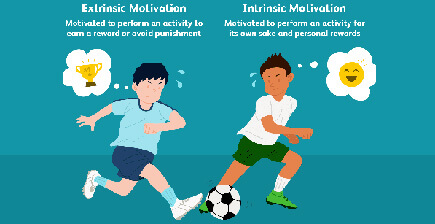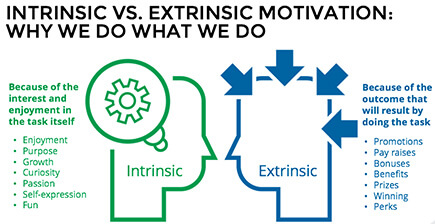Hello from Team QEDRAK!
If, you have chanced upon this blog, we recommend that you first listen to the Podcast titled Learning to Motivate the Learner – Part 1, to familiarise yourself with the topic, before proceeding.
If, however, you have reached this blog AFTER listening to the podcast titled Learning to Motivate the Learner – Part 1, then please continue reading.
As Educators, we all know deep within that ‘extrinsic motivations’ such as grades, standardized tests and financial rewards, are merely temporary incentives that cannot provide the desired ‘sustainable framework’ for quality learning, higher studies, goal accomplishments and future careers.


How then can we encourage our ‘future world citizens’ to develop their own determination to learn and succeed? How do we develop their ‘intrinsic motivation’, which we all agree, is more lasting and effective?
We must first acknowledge that there are 3 major components of motivation: –
- Activation involves the decision to initiate a behaviour towards a goal, such as – engaging in self-study to keep abreast with the class.
- Persistence is the continued effort toward a goal even though obstacles may exist. An example of persistence would be putting in extra hours every day (at the cost of some fun, games, movie, etc.) to ensure that one has had enough practice and that one is prepared at all times.
- Intensity can be seen in the concentration and vigour that goes into pursuing a goal. For example, one student might coast by without much effort, while another student will study regularly, participate in discussions, and take advantage of research opportunities outside of class. The first student lacks intensity, while the second pursues the educational goals with greater intensity.
The degree of each of these components of motivation can impact whether or not a student will achieve the goal. Strong activation, for example, means that the student is more likely to start pursuing a goal. Persistence and intensity will determine if the student will keep working toward that goal and how much effort s/he will devote to reach it.
Although it seems paradoxical to us to ‘extrinsically’ motivate our students to ‘intrinsically’ motivate themselves to be able to engage in Activation-Persistence-Intensity, there are 5 main areas in which educators can help to create an environment that will offer the ideal conditions for intrinsic motivation to develop in their students. They are:
- Area 1: Establish relationships with students and build on their strengths
- Area 2: Give the students choices whenever possible
- Area 3: Whenever you can’t give students choices, find ways to make it relevant
- Area 4: Model goal-setting and goal-tracking
- Area 5: Offer Consistent and Constructive Feedback
Within each of these areas, there are doable strategies to gain the trust of your students and learn what is meaningful to them. We hope that you will find these useful in motivating your learners.
A. Establish relationships with students and build on their strengths
“Positive relationships between teachers and students are among the most commonly cited variables associated with effective instruction. If the relationship is strong, instructional strategies seem to be more effective.” – says Robert Marzano.
Here are some great ways to build motivation by establishing sound relationships with your students.
Strategy 1: Let students show what they value most.
Strategy 2: Make better decisions by keeping and using ‘telling’ data about your students.
Strategy 3: Ask students what they expect from you and make sure you meet their expectations.
B. Give the students choices whenever possible
Many educators, agree that a sense of autonomy is a major factor in intrinsic motivation. Though there are many requirements for teachers regarding the required skills for each level, we do, generally, have autonomy over the way we can teach and assess these skills. We have the opportunity to offer some choices to the students, especially in all these areas:
Strategy 5: Give students options for HOW they want to learn something.
Strategy 6: Let students CHOOSE their own assessments.
C. Whenever you can’t give students choices, find ways to make it relevant
Students need to see connections between what they are learning and their own lives in order to feel compelled to exert effort. How many times have we heard, “When are we going to use this?” from our students (or said it ourselves)? If we can show how our lessons apply to our students’ lives, their engagement will be stronger–and, of course, that leads to greater motivation!
This is where the interest inventories and other relationship-building activities will become useful. Try some of these ideas to make real-world connections.
Strategy 7: Leverage social media.
Strategy 8: Create authentic learning experiences instead of abstract challenges.
Strategy 9: Integrate pop culture into your lessons using song lyrics, memes and clips from movies and television shows.
D. Model goal-setting and goal-tracking
When students are intrinsically motivated, they are not concerned about receiving the highest grade in the class or winning a trophy for their accomplishments. They care more about measuring their own learning and progress and less about comparing themselves to others. Here are some ways you can help them to monitor goals and achievements:
Strategy 10: Publicize goals to help students to stay accountable.
Strategy 11: Use ICT to create Vision Boards and Online Notice Boards.
Strategy 12: Give opportunities to reflect on those goals.
E. Offer Consistent and Constructive Feedback
How often have we seen some teachers underline entire assignments as s/he reads them, then write a “B” at the top of the papers–with no explanation. As you can imagine, this information is meaningless for the student, and provides no advice / guidance / direction and no opportunity for growth.
Strategy 13: Give effective and objective feedback.
Strategy 14: Give meaningful praise that will help students to know what they are doing right.
Strategy 15: Give timely feedback.
And Finally….
It is our duty as educators, however, to dissuade our students from continuously searching for immediate gratification. As we show our students that they can trust us to care about what is important to them and to work in their best interests, they will gradually learn the value of learning for their own sakes. They will find it is much more fulfilling to drive themselves than to have others drive them.


